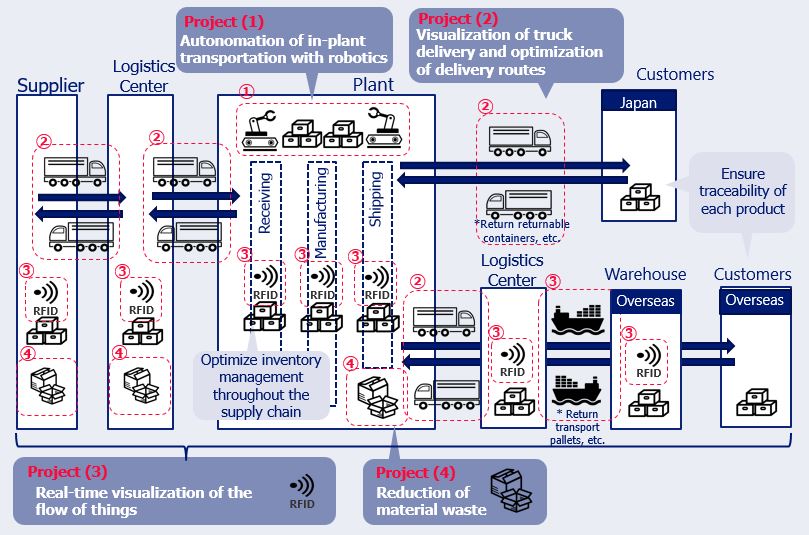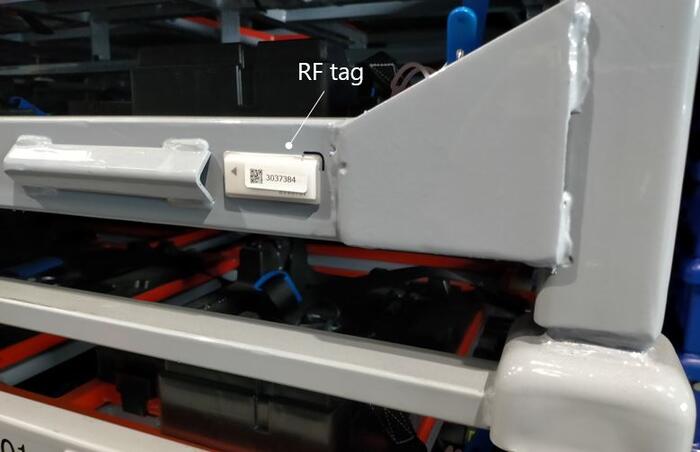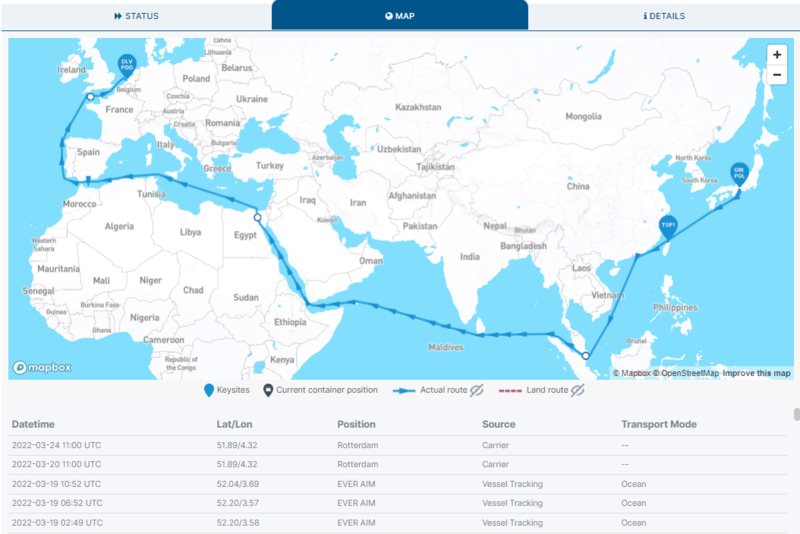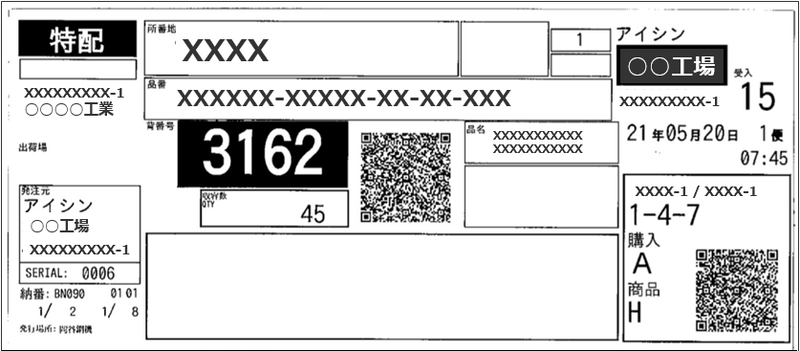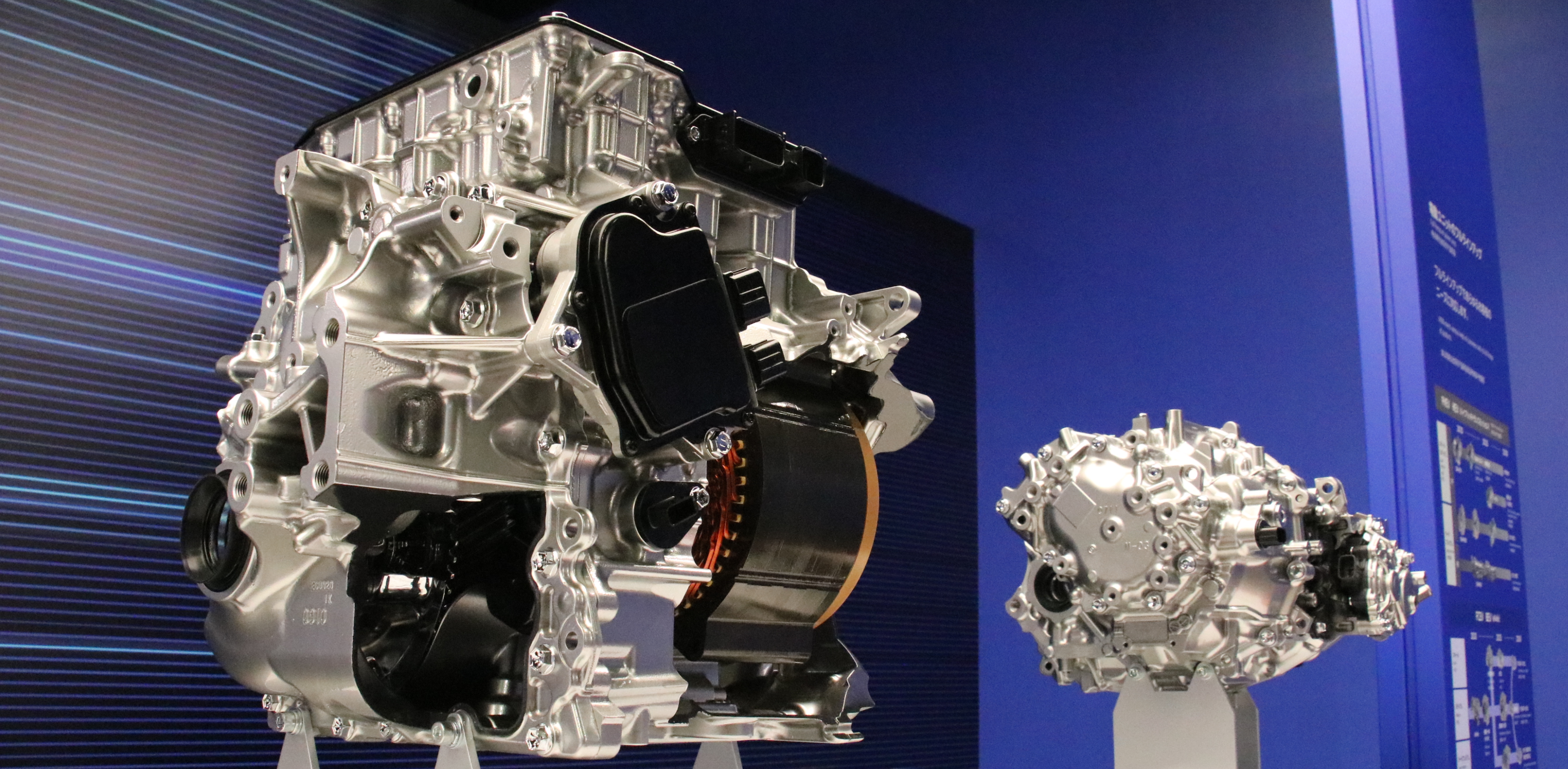Logistics Innovations That Benefit People and the Planet. What is Aisin's DX-L? [Part 2]
Jun.10, 2022
![Logistics Innovations That Benefit People and the Planet. What is Aisin's DX-L? [Part 2]](/en/aithink/assets_c/2022/07/Aisin_logistics_DX2_main-thumb-4838x2396-7335.jpg)
This is Part 2 of a series featuring Aisin’s venture into DX-L. We at Aisin are focusing on the utilization of digital technology in the logistics field to create a better working environment for our workers as well as a better global environment for all.
In this initiative, which we call “DX-L” (DX-Logistics), efforts are being made under various themes. Part 1 covers Project (1): Autonomation of in-plant transportation with robotics, and Project (2): Visualization of truck delivery and optimization of delivery routes.
Part 2 covers Project (3): Real-time visualization of the flow of things, and Project (4): Reduction of material waste.
Project (3): Real-time visualization of the flow of things to identify inventory by location
Between material procurement and product delivery to customers, “things” of various sizes are constantly being carried from one place to another at the production site. It can be difficult to track this, especially when looking at the entire supply chain and its numerous parts and locations.
However, real-time visualization of the flow of things gives you many advantages.
You can also identify inventory levels across the supply chain, which enables you to achieve total optimization of inventories. Furthermore, real-time location of each piece of product leads to higher traceability and enables prompt response in the event of a quality problem.
To visualize the flow of items, you must have a system to acquire real-time location data of them as they move.
RFID for visualization of the flow of things
In collecting location data, RFID (radio-frequency identification) works well.
RFID refers to an IoT technology that enables you to read and rewrite information in “RF tags” in a non-contact manner using radio waves.
Unlike barcodes and QR codes, you do not need to scan RF tags one by one. Just hold a scanner over RF tags or pass them through a reading gate, and multiple RF tags that are within the reach of the radio waves can be read at once. We at Aisin select the most suitable RF tags based on purpose of use and packing style.
We are building a system that automatically records the coming and going of things in the following way: information about each unique item is registered on RF tags, and the tags are attached to part boxes and products, which pass through gates installed at the entrances and exits of plants and logistics warehouses.
In building this system, Aisin is actively adopting expertise from other companies that have highly specialized capabilties through its collaboration with Phoenix Solution Co., Ltd. and Toppan Forms Co., Ltd., two companies that are highly knowledgeable about RFID.
Real-time visualization of the flow of things with this technology will automate acceptance inspection, inventory counting, and other tasks to significantly reduce man-hours, in addition to the above-mentioned effects: a shorter lead time, optimized inventories across the supply chain, and higher traceability. Through this initiative, we are aiming to halve both overall time to delivery and distribution costs.
Expansion of our efforts to visualize the flow of things into international logistics
Our efforts to visualize the flow of things are expanding into international logistics.
Aisin mainly uses ships as a means of transportation to overseas. We will dramatically enhance efficiency in our international logistics management by acquiring ship location data in real time and sharing it across the Aisin Group.
We export many domestically produced parts and products overseas. Depending on their destination, these items may travel thousands of kilometers for months. It is not uncommon for them to arrive ahead of or behind schedule due to various factors that may arise during the voyage, such as bad weather.
In recent years, the COVID-19 pandemic has diminished the handling capacity of ports and caused a shortage of shipping containers, resulting in port congestion and navigation delays worldwide. Coupled with soaring freight rates and growing geopolitical risks, international logistics has been increasingly thrown in turmoil.
These situations have been affecting us, considerably derailing our transportation and inventory plans.
Until our product-packed shipping containers arrive at the destination, our logistics staff manually check the information provided on the shipping companies’ websites to determine whether or not the ships are sailing on schedule, if any are delayed, and whether or not the products are likely to arrive by the delivery deadline.
In the Aisin Group, a total of nearly 200 staff members are involved in these checks, which is quite a huge burden of work.
To streamline this task, we are working on the visualization of shipping container location information.
With the cooperation of project44, which provides an advanced supply chain visibility platform, we will acquire accurate real-time information on the transportation status of marine freight and share the information across the Aisin Group. This will enable us to quickly respond to unexpected turmoil in collaboration with internal departments and affiliated companies.
Through the visualization of the flow of things across borders, we will alleviate the work burden of import and export control, reduce logistics costs, and optimize inventories across the global supply chain.
Project (4): Reduction of material waste to halve CO2 emissions
When it comes to efforts to reduce CO2 emissions in logistics, people tend to focus on those caused by transportation, including exhaust from trucks. However, it should be noted that many materials are used in transportation, emitting significant amounts of CO2 before they are discarded.
Digitization of kanban
Kanban refers to a management sheet that bears a product name, a product number, a storage location, and other information. At Aisin, we have begun an effort to digitize kanban to eliminate paper waste. At our plants, kanban is attached to each container of parts and products for logistics management.
Annually, we use 150 million sheets of kanban. The CO2 emitted before they are recycled as used paper amounts to approximately 3,000 tons per year.
As an effective means of reducing the amount of kanban waste, we have identified RFID, the tool mentioned above in relation to Project (3). Information in RF tags can be visually checked at the site using a reading device. We are promoting replacement of paper with RF tags by giving the same function as paper kanban to the tags. Our effort toward digitalization to eliminate the use of paper for kanban is in progress.
This effort will not only eliminate almost all the CO2 emissions attributed to kanban sheets before they are discarded and through recycling, but also dispense with barcode reading (approx. 130 hours/day in the entire process) and man-hours for acceptance inspection and inventory counting, significantly enhancing work efficiency.
Packing style optimization
Along with the digitization of kanban, we are reducing the amount of packing material waste.
Aisin discards a total of approximately 110,000 tons of packing materials per year, including approx. 60,000 tons of cardboard and approximately 50,000 tons of plastic packing materials. The volume is equivalent to approximately nineteen 25-meter pools, and the amount of CO2 emitted through the disposal of these materials is estimated to reach 30,000 tons per year.
Our waste reducing activities are based on the “4Rs”: reduce, reuse, and recycle, plus renewable.
Throughout the process from suppliers to customers, we are reconsidering excessive packing and promoting local procurement and other activities to shorten transportation distance and reduce the amount of load, thereby reducing waste from what we use in the logistics field.
Packing styles used to be determined at individual plants based on the experience and intuition of people in charge, and there has been no active collaboration among plants, including the sharing of know-how.
For packing style optimization at all plants including those outside Japan, we are aiming for packing style design that does not rely on individual workers’ intuition or knack.
For example, we will create a database of the packing styles of parts and products at our plants and achieve unified management on a common platform for packing styles optimized through the 4Rs activities. When deciding on a packing style for a new item, we will be able to search the database for similar cases, which will considerably reduce the time and labor required to make the decision.
Moreover, for further optimization, we will combine the database with simulation software to develop a system that proposes the optimum packing style based on the 3D data of parts and products from various perspectives, including the amount of CO2 emissions, weight, and size.
Through these efforts to digitize kanban and optimize packing styles, we aim to halve both CO2 emissions attributed to material waste and the amount of material waste by 2030.
We will continue to strive for digital-based work reforms and CO2 emissions reduction throughout the supply chain, contributing to the achievement of carbon neutrality and people’s freedom and happiness.





